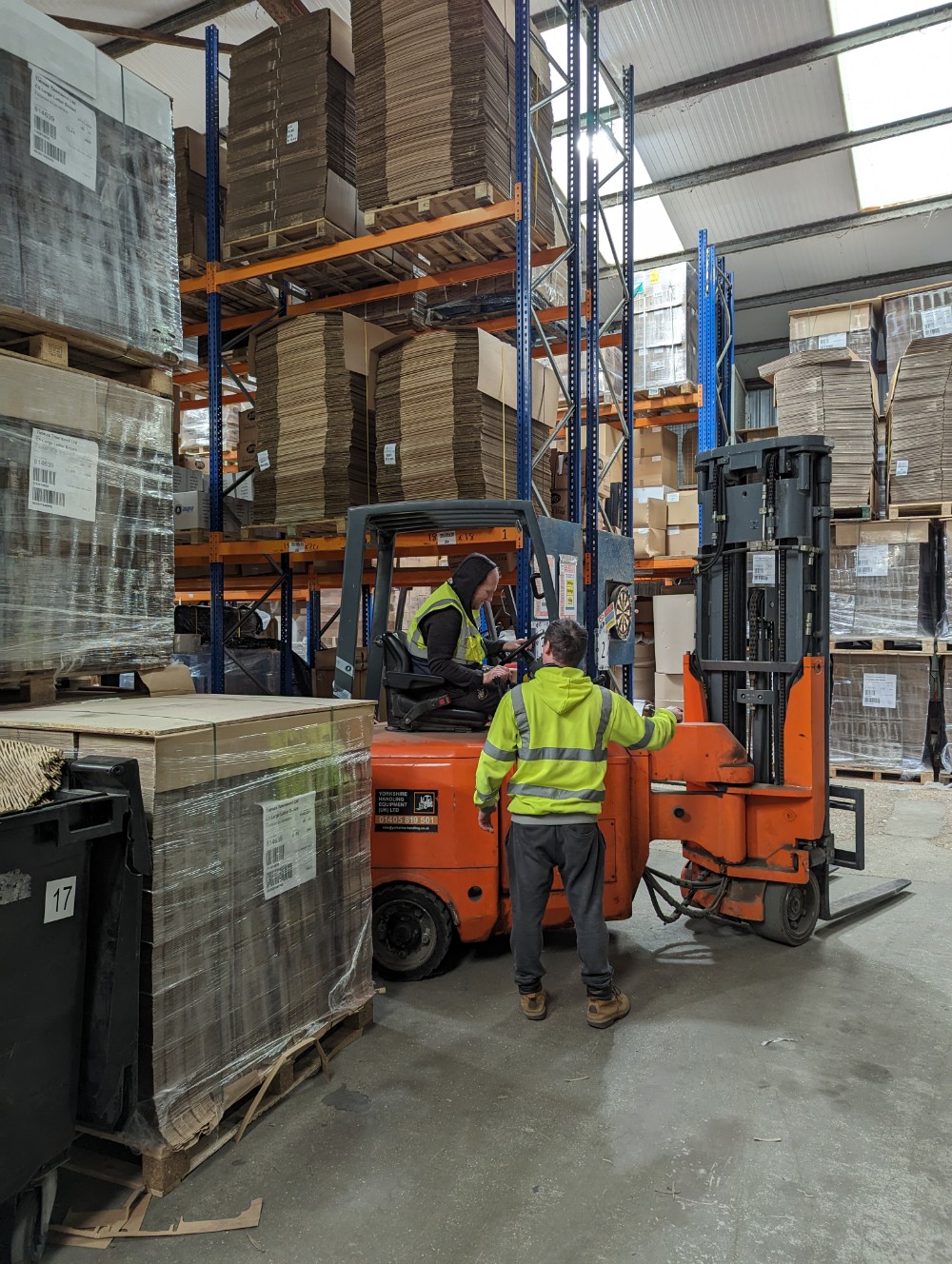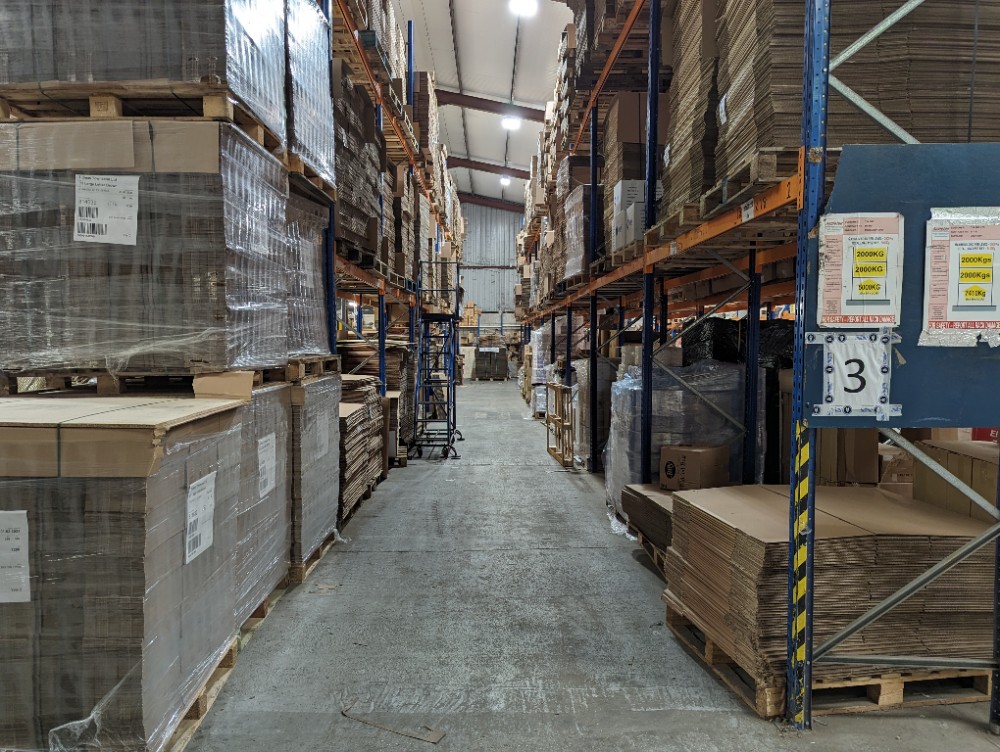Blog - The Impact of Packaging Choices on Logistics Operations

The choice of packaging has far-reaching implications, from protecting products against damage to impacting the environmental footprint of shipping processes. Logistics firms can opt for standard-sized packaging or benefit from greater flexibility with custom-made packaging. Below, we explore how each type can influence various aspects of logistics operations, including cost, efficiency, environmental impact and brand representation.
Streamlining Warehouse Operations
Efficient packaging designs aid in better organising and storing products in warehouses. Designs that are easy to handle and stack can speed up the process of moving goods in and out of storage. This efficiency in storage and retrieval directly impacts the overall throughput of logistics operations.
Optimising Transportation
Packaging influences how goods are loaded onto transport vehicles. Efficiently designed packaging can maximise the use of available space in trucks, ships or aeroplanes, leading to cost savings in transportation.
Packages that are uniform in size and shape can be more easily arranged, reducing the time and effort needed for loading and unloading, and even reducing the environmental impact of transportation by requiring fewer journeys.
Protection and Safety
The primary purpose of packaging is to protect the goods it encases. Well-designed packaging guards against damage during transit, handling and storage. This is particularly important for fragile items, electronics or perishable goods.
The right packaging reduces the risk of damage, which in turn decreases the cost associated with returns, replacements and insurance claims. For instance, the use of custom foam inserts or reinforced corners in packaging can provide additional safety for delicate items.
Compliance and Liability
For logistics operations, ensuring compliance and liability in packaging is critical. Proper packaging safeguards goods during transit, aligning with the industry's stringent standards, especially for hazardous materials, while international environmental requirements also govern the packaging decisions that logistics firms must make.
This compliance, going beyond legal requirements, helps mitigate risks such as product damage and potential accidents. It also strengthens the credibility and trustworthiness of logistics services, crucial for maintaining smooth and reliable operations. Efficient packaging compliance strategies, including regular risk assessments and adherence to standards, play a vital role in ensuring both safety and operational efficiency.
Standard packaging options include cardboard boxes, plastic containers, pallets and shrink wrap, among others, that adhere to general specifications rather than being tailored to specific products.
The Advantages of Standard Packaging
- Cost-Effectiveness: One of the most significant advantages of standard packaging is its cost-effectiveness. Due to mass production, these packaging materials are usually available at a lower cost per unit compared to custom solutions. For logistics companies managing tight budgets, this cost-saving aspect can be a crucial factor in their operational strategy.
- Availability: Standard packaging is readily available and can be quickly sourced from suppliers, reducing lead times. This high availability is particularly advantageous in situations where rapid packaging solutions are needed, ensuring that there are no delays in the supply chain.
- Ease of Use: Standard packaging, with its uniform sizes and familiar designs, is generally easy to handle and use. Warehouse staff and logistics personnel are often already trained in handling these standard packaging types, streamlining the packing process and reducing the need for specialised training.
The Challenges of Standard Packaging
- Limited Customisation: The biggest drawback of standard packaging is the limited scope for customisation. Standard sizes and shapes may not be the perfect fit for all products, leading to inefficiencies in packing, increased use of void-fill materials and potentially higher transportation costs due to underutilised space.
- Branding Limitations: Standard packaging offers limited opportunities for branding and marketing. For businesses looking to make a strong brand statement through their packaging, the generic nature of standard packaging can be a significant limitation, reducing the ability to stand out in crowded markets.
- Protection for Diverse Products: While standard packaging can be suitable for many products, it may not offer adequate protection for items that are fragile, uniquely shaped or require special handling. This can lead to increased risks of product damage during transit, impacting customer satisfaction and incurring additional costs in returns and replacements.

This can include items such as custom-made cardboard boxes or bespoke printed packaging with custom logos, branding or messaging.
The Advantages of Custom Packaging
- Enhanced Product Security: Custom packaging provides exacting protection for items in transit, minimising movement and potential damage. This level of customisation is particularly beneficial for sensitive or high-value items, ensuring they reach their destination in top condition.
- Branding Potential: A custom-designed package can serve as a strategic branding tool, allowing for the addition of corporate identity. The custom design can incorporate brand colours, logos and essential messaging, turning each package into an extension of the brand experience.
- Sustainability Focus: With the ability to tailor the size and materials to the product, custom packaging can significantly reduce waste. Using recyclable materials or reducing packaging size aligns with eco-friendly initiatives, a growing concern in consumer and corporate landscapes.
The Challenges of Custom Packaging
- Cost Considerations: The cost of custom packaging solutions can be higher than standard options when considering the design, prototyping and manufacturing processes involved. This means evaluating the return on investment and considering the long-term value of such an approach. In these cases, a custom pricing strategy, such as that offered to our customers at Tidmas Townsend, can be invaluable for securing the best deal.
- Complexity in Design and Supply Chain: Implementing custom packaging solutions requires a thorough design process, which can introduce complexity into the supply chain. Integrating these solutions requires careful planning with an experienced packaging manufacturer to avoid disruptions in logistics operations.
- Volume Requirements: Often, the production of custom packaging is constrained by minimum order requirements, which can be a hurdle for smaller-scale operations or for products with fluctuating demand. A packaging solution with low minimum order values, such as Tidmas Townsend, can help address this concern.
Standard Packaging
Standard packaging, with its uniform sizes and shapes, simplifies the process of storage and stacking. Warehouses equipped to handle these standard dimensions can optimise their layout for these packages, leading to efficient use of space and streamlined inventory management.
However, the one-size-fits-all nature of standard packaging might not always offer the best fit for all products, potentially leading to inefficient space usage or the need for additional packing materials to secure goods.
Custom Packaging
While it may require more complex logistics planning, custom packaging can maximise space utilisation in a warehouse. Products can be packed more densely and securely, reducing the need for excessive shelf space and minimising the risk of damage during handling. This can be particularly beneficial for products with irregular shapes or delicate components that demand additional protection.
Custom packaging can be designed to integrate seamlessly with automated warehouse systems. Features like built-in handles or specific shapes conducive to automation can enhance the speed and efficiency of operations, from packing to palletising. This integration is crucial in modern warehouses where automation plays a key role in maintaining high throughput rates.

The choice between standard and custom packaging is no longer just a logistical decision but a statement of a commitment to sustainability. This alignment with green logistics practices not only satisfies consumer demand for environmental stewardship but also positions your business as forward-thinking and responsible.
Standard Packaging
Standard packaging, when produced from recycled or biodegradable materials, for example, presents an opportunity for companies to reduce their carbon footprint. The streamlined nature of these packages can also mean a more straightforward recycling process for post-consumer use.
Custom Packaging
Custom packaging, on the other hand, takes sustainability a step further by allowing for the precise sizing of packages to fit the product, minimising waste. It can eliminate the need for additional filler materials and reduce the overall volume of packaging required, leading to decreased material use and lower emissions during transportation. When designed with eco-friendly materials, custom packaging solutions can similarly contribute to your green credentials.
Custom packaging, on the other hand, excels in providing tailored protection and unique branding opportunities but can come with considerations of higher costs and design complexities.
Our range of packaging solutions is designed to meet the multifaceted demands of modern logistics operations, balancing efficiency, sustainability and customisation. We invite you to explore our offerings and discover how we can help streamline your operations with quality custom and standard-sized packaging.
Click to view our range of custom boxes and bespoke printed packaging.













